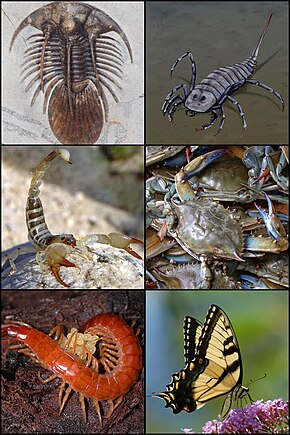Euarthropod
| Arthropod Temporal range: 540–0 Ma Cambrian–Holocene |
|
|---|---|
 |
|
| Extinct and modern arthropods | |
| Scientific classification | |
| Kingdom: | Animalia |
| Superphylum: | Ecdysozoa |
| (unranked): | Panarthropoda |
| (unranked): | Tactopoda |
| Phylum: |
Arthropoda von Siebold, 1848 |
| Subphyla, unplaced genera, and classes | |
|
|
| Synonyms | |
|
Condylipoda Latreille, 1802 |
|
Condylipoda Latreille, 1802
An arthropod (from Greek ἄρθρον arthron, "joint" and πούς pous, "foot") is an invertebrate animal having an exoskeleton (external skeleton), a segmented body, and jointed appendages (paired appendages). Arthropods form the phylum Arthropoda, which includes insects, arachnids, myriapods, and crustaceans. Arthropods are characterized by their jointed limbs and cuticle made of chitin, often mineralised with calcium carbonate. The arthropod body plan consists of segments, each with a pair of appendages. The rigid cuticle inhibits growth, so arthropods replace it periodically by moulting.
Their versatility has enabled them to become the most species-rich members of all ecological guilds in most environments. They have over a million described species, making up more than 80% of all described living animal species, some of which, unlike most animals, are very successful in dry environments.
Arthropods range in size from the microscopic crustacean Stygotantulus up to the Japanese spider crab. Arthropods' primary internal cavity is a hemocoel, which accommodates their internal organs, and through which their haemolymph – analogue of blood – circulates; they have open circulatory systems. Like their exteriors, the internal organs of arthropods are generally built of repeated segments. Their nervous system is "ladder-like", with paired ventral nerve cords running through all segments and forming paired ganglia in each segment.
...
Wikipedia
